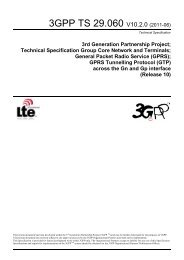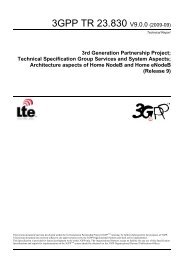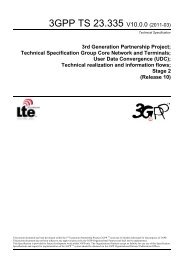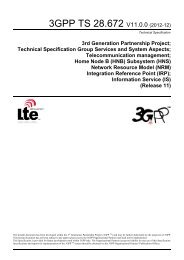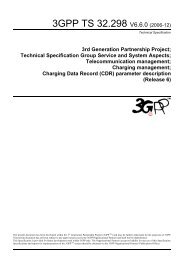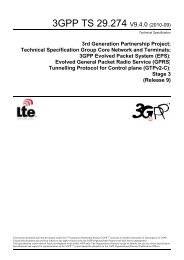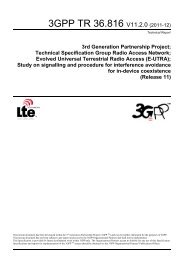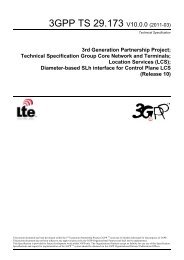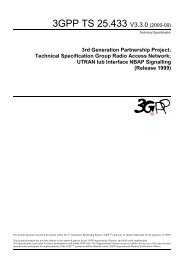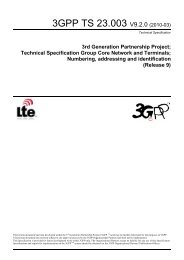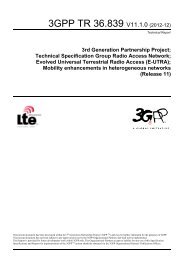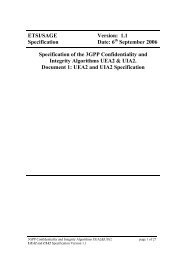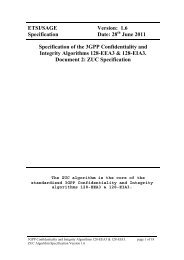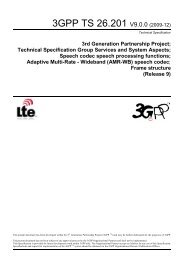3GPP TS 36.212, "Multiplexing and channel coding"
3GPP TS 36.212, "Multiplexing and channel coding"
3GPP TS 36.212, "Multiplexing and channel coding"
Create successful ePaper yourself
Turn your PDF publications into a flip-book with our unique Google optimized e-Paper software.
Release 8<br />
30<br />
<strong>3GPP</strong> <strong>TS</strong> <strong>36.212</strong> V8.1.0 (2007-11)<br />
5.2.2.8 Channel interleaver<br />
The <strong>channel</strong> interleaver described in this subclause in conjunction with the resource element mapping for PUSCH in [2]<br />
implements a time-first mapping of modulation symbols onto the transmit waveform while ensuring that the control<br />
information is present on both slots in the subframe <strong>and</strong> is mapped to resources around the uplink demodulation<br />
reference signals.<br />
The bits input to the <strong>channel</strong> interleaver are denoted by g , g , g ,..., g , where H ′ is the number of modulation<br />
0 1 2 H ′−1<br />
symbols in the subframe. The output bit sequence from the <strong>channel</strong> interleaver is derived as follows:<br />
PUSCH<br />
(1) Assign C mux = N symb to be the number of columns of the matrix. The columns of the matrix are numbered 0,<br />
1, 2,…, C −1<br />
from left to right.<br />
mux<br />
(2) The number of rows of the matrix is R mux = H / Cmux<br />
<strong>and</strong> we define R mux<br />
′ = Rmux<br />
/ Qm<br />
.<br />
The rows of the rectangular matrix are numbered 0, 1, 2,…, R −1<br />
from top to bottom.<br />
(3) Write the input vector sequence, i.e.,<br />
starting with the vector<br />
y = g for k = 0, 1,…, H ′ −1<br />
, into the ( )<br />
k k<br />
mux C mux<br />
y in column 0 <strong>and</strong> rows 0 to ( Q −1)<br />
:<br />
0<br />
m<br />
mux<br />
R × matrix by Q m rows<br />
⎡<br />
⎢<br />
⎢<br />
⎢<br />
⎢<br />
⎢y<br />
⎣<br />
y<br />
y<br />
0<br />
Cmux<br />
M<br />
( Rmux<br />
′ −1)<br />
× Cmux<br />
y<br />
y<br />
y<br />
1<br />
Cmux<br />
+ 1<br />
M<br />
( Rmux<br />
′ −1)<br />
× Cmux<br />
+ 1<br />
y<br />
y<br />
y<br />
2<br />
Cmux<br />
+ 2<br />
M<br />
( Rmux<br />
′ −1)<br />
× Cmux<br />
+ 2<br />
L<br />
L<br />
O<br />
L<br />
y<br />
y<br />
y<br />
Cmux<br />
−1<br />
2Cmux<br />
−1<br />
M<br />
( Rmux<br />
′ × Cmux<br />
−1)<br />
⎤<br />
⎥<br />
⎥<br />
⎥<br />
⎥<br />
⎥<br />
⎦<br />
[Note from the editor: if part of the control information punctures the data transmission, this is a good place to<br />
perform the operation]<br />
(4)The output of the block interleaver is the bit sequence read out column by column from the ( R mux × C mux ) matrix.<br />
The bits after <strong>channel</strong> interleaving are denoted by h<br />
0<br />
h1<br />
, h2<br />
,..., h H 1<br />
.<br />
5.2.3 Uplink control information<br />
,<br />
−<br />
Data arrives to the coding unit in form of indicators for measurement indication, scheduling request <strong>and</strong> HARQ<br />
acknowledgement.<br />
Three forms of <strong>channel</strong> coding are used, one for the <strong>channel</strong> quality information (CQI), another for HARQ-ACK<br />
(acknowledgement) <strong>and</strong> scheduling request <strong>and</strong> another for combination of <strong>channel</strong> quality information (CQI) <strong>and</strong><br />
HARQ-ACK.<br />
a0 ,...,<br />
, a1<br />
a A −1<br />
b0 ,...,<br />
, b1<br />
b B −1<br />
Figure 5.2.3-1: Processing for UCI<br />
5.2.3.1 Channel coding for UCI HARQ-ACK<br />
Details for the coding of the HARQ acknowledgement message. Need to include the possibility of repetition. Also need<br />
to include the coding when the control is multiplexed with the data.<br />
<strong>3GPP</strong>



